

2015 Power Transmission Products
General Information
168
240 - 300 in.
300 in. & Over
60
29
Dry Can Belts
Cross Section
12 - 118 in. Length
5MR
200
7MR
124
11MR
85
Neothane® Belts
Cross Section
12 - 118 in. Length
“J” Section
10 in. - 120 in. = 400 ribs
“L” Section
25 in. - 120 in. = 200 ribs
“M” Section
50 in. - 118 in. = 100 ribs
“K” Section
12 in. - 120 in. = 265 ribs
Poly-V® Belts
(Cut-Edge Only)
Belt Storage
General guidelines
The storage of power transmission belts is of interest to users
and distributors as well as manufacturers. Under favorable
storage conditions, good quality belts retain their initial
serviceability and dimensions. Conversely, unfavorable
conditions can adversely affect performance and cause
dimensional change. Good storage facilities and practices will
allow the user to achieve the most value from belt products.
Power transmission belts should be stored in a cool and dry
environment with no direct sunlight. When stacked on shelves,
the stacks should be small enough to avoid excess weight on
the bottom belts which may cause distortion. When stored in
containers, the container size and contents should be sufficiently
limited to avoid distortion, particularly to those belts at the
bottom of the container.
Some things to avoid
Do not store belts on floors unless a suitable container is
provided. They may be susceptible to water leaks or moisture
or otherwise damaged due to traffic.
Do not store belts near windows which may permit exposure
to sunlight or moisture. Do not store belts near radiators, or
heaters or in the airflow from heating devices.
Do not store belts in the vicinity of transformers, electric
motors or other electrical devices that may generate ozone.
Also avoid areas where evaporating solvents or other chemicals
are present in the atmosphere.
Do not store belts in a configuration that would result in bend
diameters less than the minimum recommended sheave or
pulley diameter for normal bends and not less than 1.3 times
the minimum recommended diameters for reverse bends.
(Refer to appropriate ARPM-MPTA-RAC Standards for minimum
recommended diameters.)
Overview
Synchronous
Banded
V-Belt
Bushing Hardware
Specialty
Automotive & Truck
General Information

















